Statics How to Draw Free Body Diagrams
Affiliate 4: Rigid Bodies
four.2 Rigid Torso Free Body Diagrams
Following what we learned in Department two.2 on particle Gratis-Body Diagrams (FBDs), this department will expand on that for rigid bodies. The biggest deviation betwixt a particle and rigid body FBD is where the forcefulness is applied. In a rigid body FBD, y'all have to exist precise virtually pointing the head of the forcefulness arrow to the location where it applied. For example. if nosotros wanted to make a FBD of you and me high-5'ing, you would apply the force from your paw onto my hand, not at my center of mass.
In this section, first we will learn how to do a FBD for a part, so we expect at how to model a system of multiple objects.
When modelling a single object using an FBD, you are simplifying a complex problem into specific forces using arrows and an object floating in space. The floor becomes a normal forcefulness arrow and a frictional force arrow. Pushing or pulling on an object becomes an applied force with the arrow pointing to or from (pushing or pulling) the location where the pushing or pulling occurs. Retrieve the rules from section ii.2 withal apply:
- Add coordinate frame (which way is positive 10 and positive y?)
- Supersede surfaces with forces (floor, hand, and objects touching information technology become arrows)
- Bespeak forces in the correct direction (the caput of the arrow points to where the strength acts. FG acts downward)
- Utilize unique (different) names (exist certain to proper noun each force with a different name).
Here are some tips to keep in listen virtually each of the forces:
- Gravity acts on every particle in an object. Considering we don't want a one thousand thousand piffling arrows on the object, we sum the effect of gravity at the center of mass. This is also considering we mostly know the total mass of something and where that occurs on an object (frequently at the geometric center), so we concentrate the force of gravity at this eye of mass.
- Normal forces always act perpendicular to the surface, so if the footing is at an bending, then the normal force acts 90 degrees from that angle (perpendicular).
- Frictional forces human action parallel to the aeroplane between the ii surfaces. This makes it a shear forcefulness, which nosotros'll expect at in Affiliate 6.
- Friction always opposes motion, a fact that volition be very of import in your dynamics class.
- Spring force is oft shown equally negative because the force acts in the opposite direction of the move traveled. In application, y'all fix the direction of the frictional force to match if it is pushing or pulling.
- Applied forces (and moments), such equally distributed loads, motors, pushing on an object, tension, etc.
The steps to brand a FBD are:
- Draw shape
- Add coordinate frame
- Replace forces with arrows
- Label each forcefulness uniquely
To model a book being pushed across the table, yous would utilize the following forces at the post-obit locations (see image below)
- the normal strength on the bottom of the volume (green arrow)
- the frictional force running along the bottom surface between the book and table (yellowish pointer)
- the gravitational forcefulness interim at the center of mass (pinkish arrow)
- any applied force at the point of application, such equally your paw pushing on the book (bluish pointer)
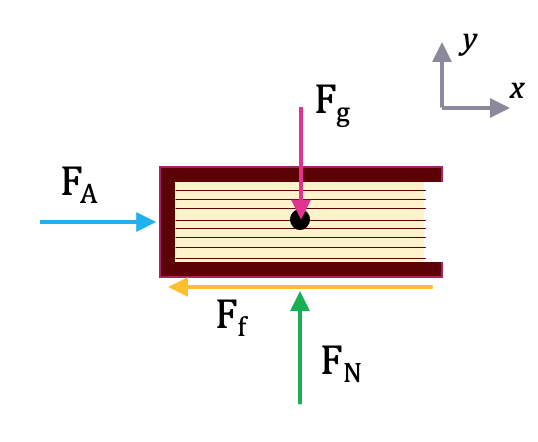
If instead, the book were being pulled by a string, the image would exist the aforementioned but the applied force and frictional force would change direction (because friction e'er opposes motility).
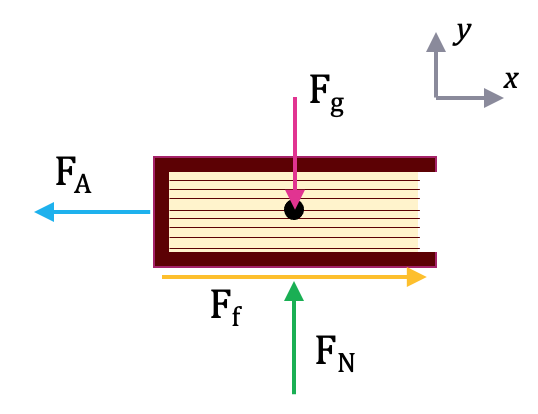
A free trunk diagram is a tool used to solve engineering mechanics problems. As the proper name suggests, the purpose of the diagram is to "costless" the torso from all other objects and surfaces around it so that information technology tin be studied in isolation. We will also draw in any forces or moments acting on the body, including those forces and moments exerted by the surrounding bodies and surfaces that we removed.
The diagram below shows a ladder supporting a person and the free body diagram of that ladder. Equally you can see, the ladder is separated from all other objects and all forces acting on the ladder are drawn in with key dimensions and angles shown.
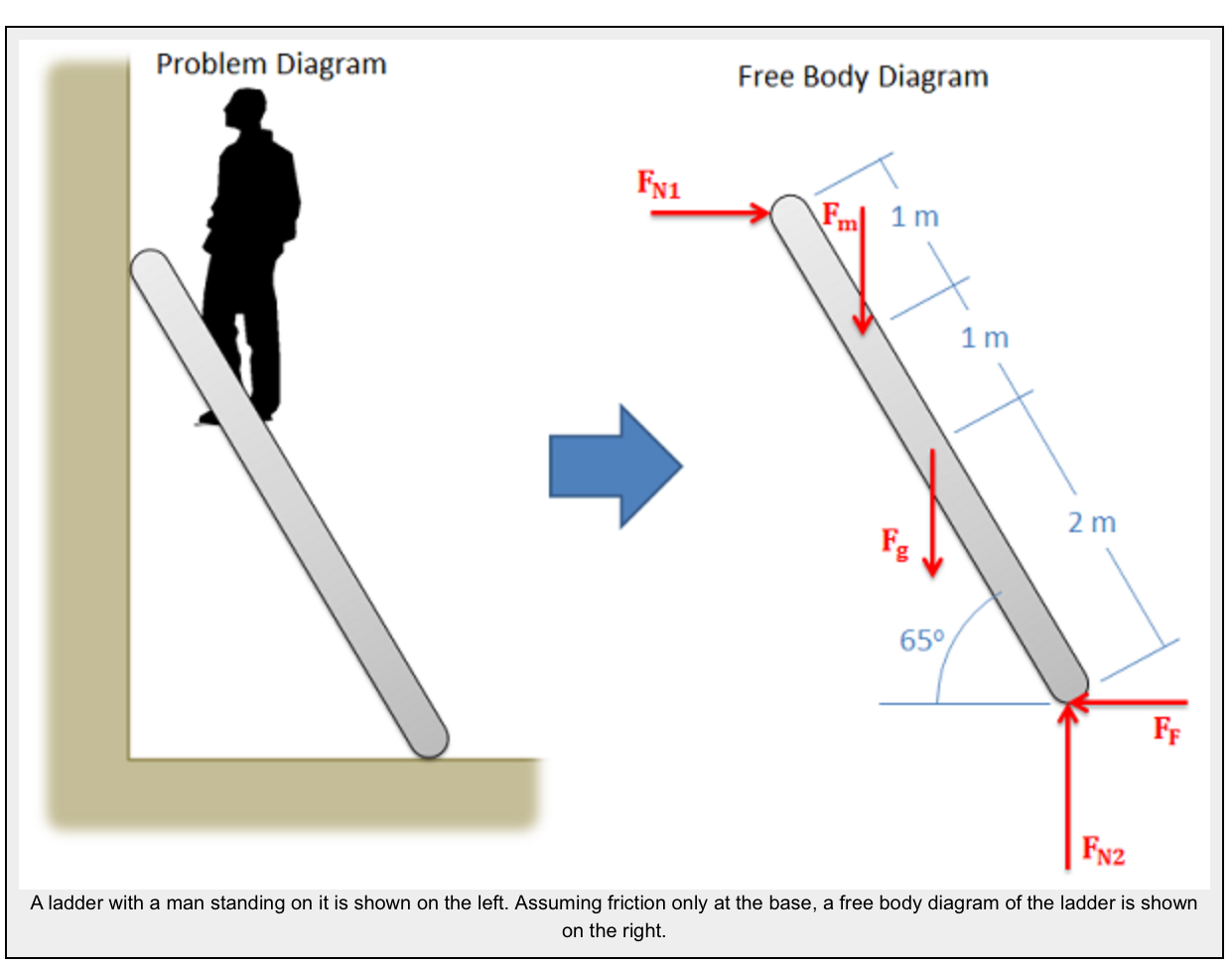
The kickoff stride in solving most mechanics problems will be to construct a gratis body diagram. This simplified diagram volition allow us to more easily write out the equilibrium equations for statics or strengths of materials problems, or the equations of motion for dynamics issues.
To construct the diagram we will use the post-obit process.
- First draw the body being analyzed, separated from all other surrounding bodies and surfaces. Pay close attending to the purlieus, identifying what is part of the body, and what is part of the surround.
- Second, depict in allexternal forces and moments acting direct on the body. Practice not include whatsoever forces or moments that exercise not straight act on the body being analyzed. Do not include any forces that areinternal to the body existence analyzed. Some mutual types of forces seen in mechanics bug are:
- Gravitational Forces: Unless otherwise noted, the mass of an object will effect in a gravitational weight force applied to that body. This weight is normally given in pounds in the English language system, and is modeled as 9.81 (g) times the mass of the torso in kilograms for the metric system (resulting in a weight in Newtons). This forcefulness will ever bespeak down towards the center of the earth and act on the center of mass of the body.
- Gravitational Forces: Unless otherwise noted, the mass of an object will effect in a gravitational weight force applied to that body. This weight is normally given in pounds in the English language system, and is modeled as 9.81 (g) times the mass of the torso in kilograms for the metric system (resulting in a weight in Newtons). This forcefulness will ever bespeak down towards the center of the earth and act on the center of mass of the body.
- One time the forces are identified and added to the free torso diagram, the last stride is to label any key dimensions and angles on the diagram.
Source: Engineering science Mechanic, Jacob Moore, et al. http://wwhttp://mechanicsmap.psu.edu/websites/1_mechanics_basics/1-6_free_body_diagrams/free_body_diagrams.htmlw.oercommons.org/courses/mechanics-map-open-mechanics-textbook/view
A system gratis-torso diagram is composed of multiple parts, so yous can accept multiple 'levels' to consider: the system level with all objects on the same FBD, and a part FBD for each private part. This is especially helpful if you accept a more unknowns than equations when using the equilibrium equations, so you can find more information by splitting the organisation upwards into private parts.
For the system FBD, you look at the parts combined together and add just the external forces (gravity, applied, normal, frictional, bound). When yous look at each part separately, y'all now have to include the interaction betwixt the objects, replacing a part with forces (by and large 2 forces: vertical and horizontal force).
For case, if there are 2 books stacked on top of each other, you now need 3 FBDs:
- a arrangement level FBD with both books,
- a function FBD for the bottom book with the meridian volume replaced by arrows (forces)
- a function FBD for the peak book with the bottom book replaced by arrows (forces)
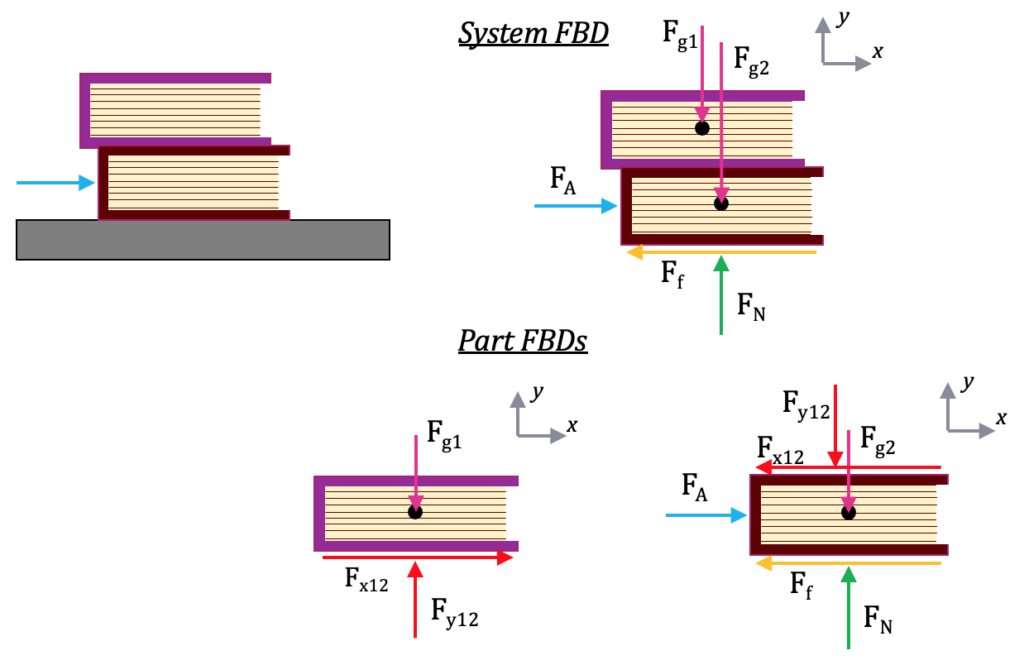
To make a organization FBD:
- Draw system FBD using unique consistent labels (ie. a letter or number per office)
- The system should exist floating in space with no surface (such equally the flooring)
- Include coordinate frame
- Use just external forces on system FBD (gravity, applied, normal, frictional, spring).
- Do NOT include internal forces
- It is particularly of import to utilise unique labels, so the top volume forces are labelled i, and the bottom volume forces are labelled 2 (or T for summit and B for bottom, or A and B).
- Draw a FBD for each office separately & coord frame with equal and opposite arrows for internal system forces
-
- The function should exist floating in space with no surfaces or other objects
- Include a coordinate frame (yeah, again! This is to ensure you didn't rotate the object).
- Copy the external forces onto the part FBD from the system FBD with the identical labels and arrow directions
- At present add internal forces replacing the other object with force arrows (crimson arrows)
- When you draw the second function FBD, follow the above bullets for the 2d object (with label 2 instead of 1, copying the organisation level external force labels). Annotation though that yous use the same labels for the internal forces from the get-go role FBD, but the management is reversed (left becomes right and upwards becomes downwardly). Following Newton'southward laws, the objects extert equal and opposite forces on each other, and should abolish out at the system level, and so they accept the same characterization (magnitude) and opposite directions.
Some tips:
- Differentiate one object from the other through the labels, using either a letter or number for each part. These same labels proceed the system level FBD (except for the internal labels).
- Utilize the same labels between the part and system FBDs for external forces. Don't change the characterization – that will make the equations incommunicable to solve and look like yous have more unknowns.
- Use the aforementioned unique labels between the internal forces for the part FBDs, but in the opposite direction.
- If you know the location of the center of mass, yous could combine the gravitational forces into 1 organization level gravitational force. Yous could also model the gravitational force into one strength per part acting at the center of mass for each object. This is the better method if you have to carve up the objects to exercise the calculations.
Hither are some examples from: http://mechanicsmap.psu.edu/websites/1_mechanics_basics/i-6_free_body_diagrams/free_body_diagrams.html
Instance one: Function FBD
The motorcar shown below is moving and and so slams on the brakes locking up all iv wheels. The distance between the 2 wheels is viii anxiety and the centre of mass is 3 feet behind and 2.five feet to a higher place the point of contact betwixt the forepart cycle and the ground. Draw a gratuitous torso diagram of the car as it comes to a stop.


Source: Engineering Mechanics, Jacob Moore et al., http://mechanicsmap.psu.edu/websites/1_mechanics_basics/ane-6_free_body_diagrams/pdf/P3.pdf
Example 2: Part FBD (a beam)
Example 3: System FBD
2 equally sized barrels are being transported in a hand truck equally shown below. Depict a gratis body diagram of each of the two barrels.

Source: Engineering Mechanics, Jacob Moore et al., http://mechanicsmap.psu.edu/websites/1_mechanics_basics/1-6_free_body_diagrams/pdf/P2.pdf
External forces in green, pink, and yellow. Internal forces between the cart and barrels (C and A/B) in red and between the barrels (A & B) in blueish. Notice the matching labels for internal forces but opposing directions. Notice that the coordinate frame has been rotated consistently in all of the FBDs.
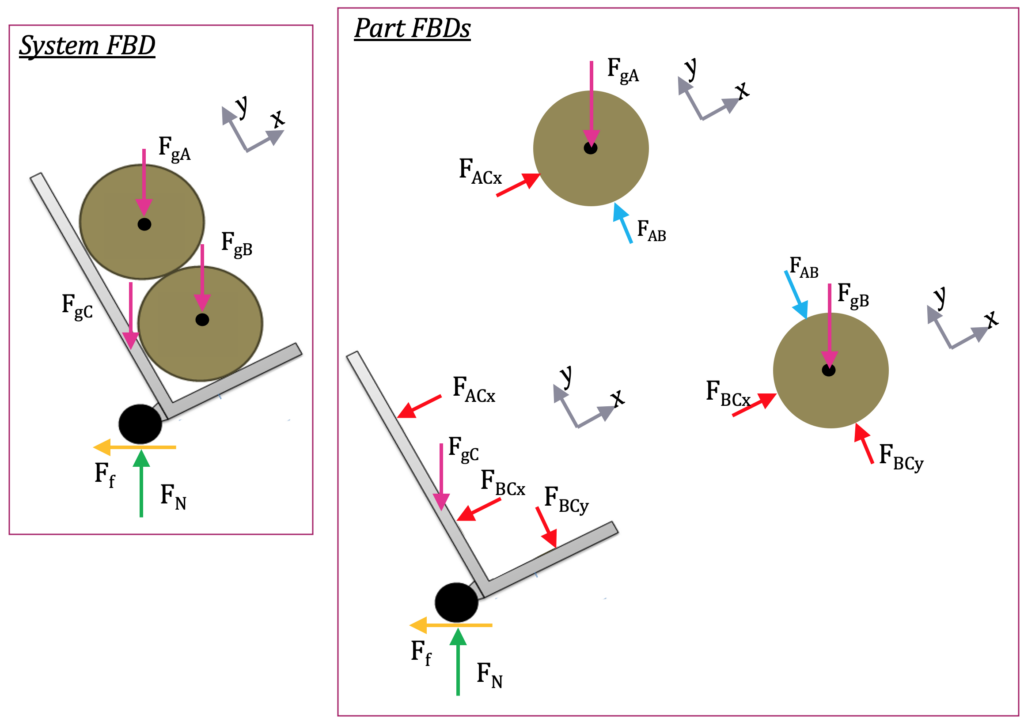
Basically: A part free-body diagrams (FBDs) give you a way to model complicated problem in a simple manner with arrows. Systems FBDs allows you lot to combine objects and clarify them separately.
Application: A bat swinging could exist modeled every bit a part FBD with gravity and multiple applied forces (hands on one end and the ball on the other). You lot could model the moment the bat and ball are touching using a organization FBD.
Looking ahead: You lot'll apply a FBD in every stride ii in about every homework problem. These are specially helpful with Equilibrium Equations in the next section.
Source: https://pressbooks.library.upei.ca/statics/chapter/free-body-diagrams-2/
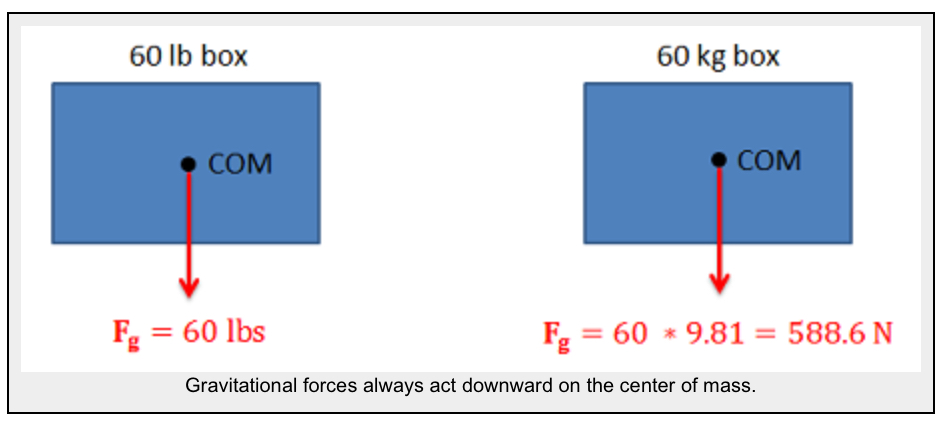
0 Response to "Statics How to Draw Free Body Diagrams"
Post a Comment